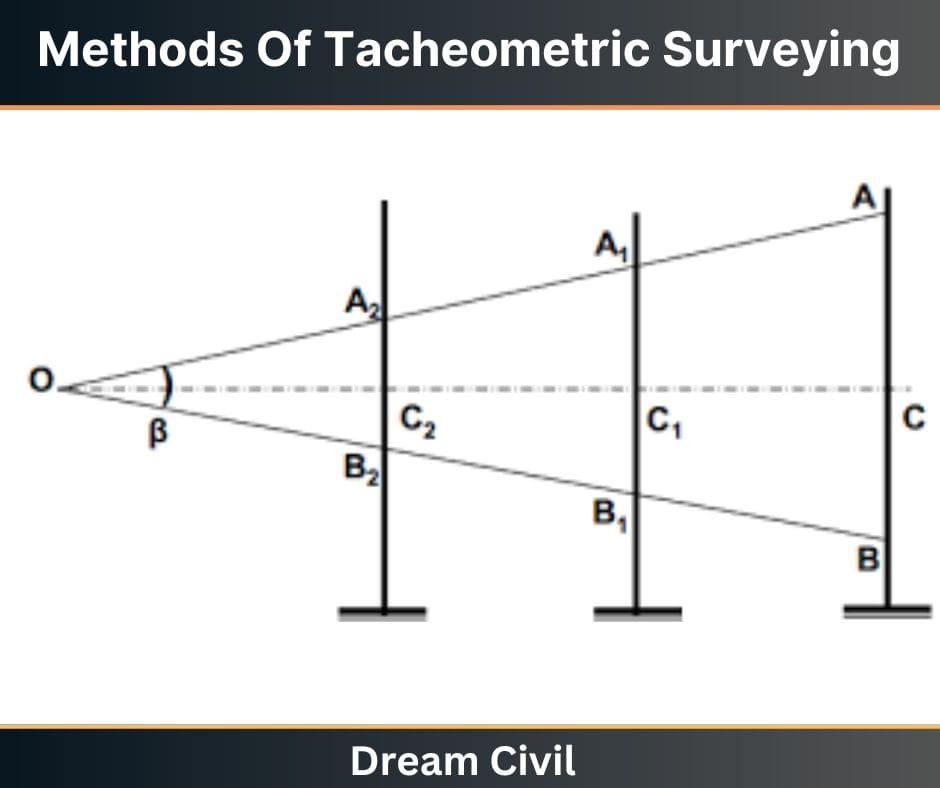Table of Contents
Before knowing about methods of tacheometric surveying. Let’s elaborate on what tacheometric surveying means.
Tacheometric surveying can also be defined as the method of rapid surveying in which the horizontal and vertical points on the earth’s surface relative to one another are determined utilizing a tacheometer. Thus, it eliminates the chaining needs.
The purpose of tacheometric surveying is the preparation of a topographic map or plan with both horizontal and vertical controls.
For the survey of high accuracy, it provides a check on the distances measured by tape.
The formula for the horizontal distance, for the tacheometer with the additive constant 0.00 and the multiplying constant 100.00 is,
H= K*s* cos²θ
The formula for the vertical distance for the same tacheometer is,
V= (K*s*sin2θ)/2 = Htanθ
Where,
S= Staff Intercept = Top Reading – Bottom Reading
K= Multiplying Constant (generally taken as 100)
θ = Vertical angle on the theodolite
Thus, after computing the vertical distance value, the reduced level of the instrument station (R.L), the height of the instrument (H.I), the central wire reading (R), and the R.L of any point under observation can be calculated as:
R.L of Point = R.L of Instrument Station + H.I ± V-R
1. Methods of Tacheometric Surveying
The methods of tacheometric surveying are as follows:
I. Stadia Method of Tacheometry
The stadia method of tacheometry is a common method adopted for determining the horizontal distance and vertical elevation.
In this method, the horizontal distance to the staff station from the instrument station and the elevation of the staff station following the line of sight of the instrument is obtained with only one observation from the instrument station.
Such a method of surveying can be further classified into the following:

a. Fixed Hair Method
In this method of surveying, the instrument employed for taking the observations consists of a telescope fitted with two additional cross-hairs, one above and the other below the central hair.
Thus, stadia hairs are those hairs that are placed equidistant from the central hair.
The stadia hairs are seen to intercept a certain length of the staff when viewed from the telescope of the instrument.
This is the most widely used method of tacheometric surveying.
b. Movable Hair Method
Unlike the stadia hair method, in the movable hair method, the telescope fitted to the instrument consists of cross-hairs that can be moved.
The movable cross-hairs can also be fixed at any distance from the central hair.
In this method, the stadia interval is variable for different positions of the staff.
Then, the computation of horizontal distance is done. Two targets at a fixed distance apart are used with the instrument.
II. Tangential Method of Tacheometric Surveying
The tangential method of tacheometric surveying requires two observations from the staff station to the instrument station.
This is done to determine the horizontal distance and the difference in elevation between the line of collimation and the staff station.
The most important advantage that this method offers is that it can be conducted with ordinary transit theodolite.
This method is employed less than the stadia system because of the slow progress of work.

2. Uses of Tacheometric Surveying
The uses of tacheometric surveying are as follows:
a. The main aim of this tacheometric surveying is to make contoured maps or plans demanding both horizontal as well as vertical control.
b. On surveys of higher precision, it gives a check on distances calculated with the tape.
c. Making topographic maps that need both elevations and horizontal distances.
d. Survey work in complex terrain where direct methods are inappropriate.
e. Reconnaissance surveys for highways, railways, etc.
f. Checking of precalculated distances.
g. Used in Hydrographic surveys.
3. Advantages of Tacheometric Surveying
The followings points are benefits of tacheometric surveying are as follows:
a. It is the quickest method of surveying and is easy to execute.
b. The precision of tacheometric surveying in rough or challenging terrain is entirely acceptable.
c. Does not need any tedious jobs with tapes and chains.
d. Cost-efficient relative to time.
e. Applicable where chain survey or plane table survey cannot be performed (hilly areas, hydrographic sites).
f. It can be employed to achieve a more useful check for earlier done chain surveying outcomes.
4. Disadvantages of Tacheometric Surveying
The disadvantages of tacheometric surveying are as follows:
a. In an uneven surface, both horizontal and vertical measurements are boring and chaining is inaccurate, hard, and slow.
b. This method is mostly the quickest and most suitable for figure detection and typographic detailing only.
This was for the Methods Of Tacheometric Surveying.
5. References1. Content Filter & Authenticity Checking Team, Dream Civil International (Our team checks every content & detail to maintain quality.) |
Read Also: Heartwood Vs Sapwood

